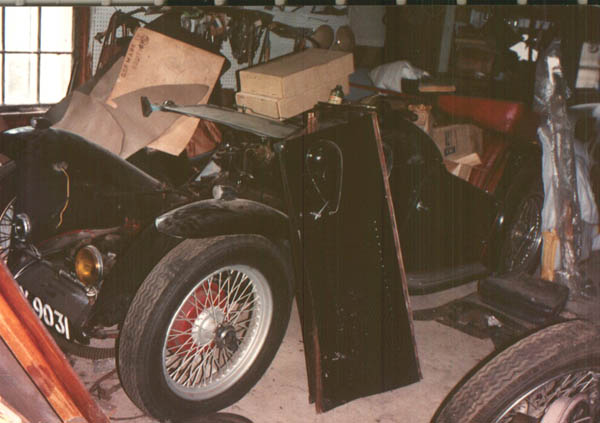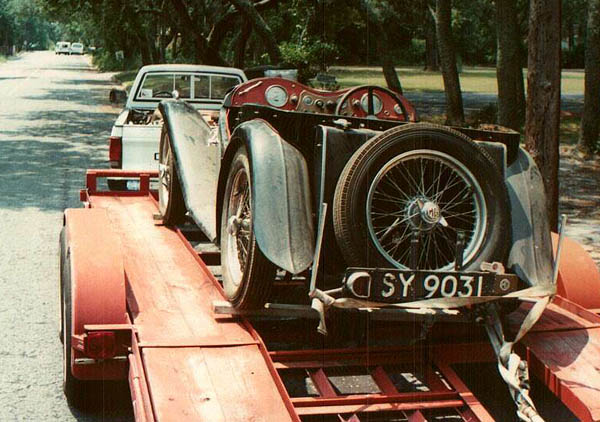




|
|
Yellow Car background I'm a hot rod wannabe but have loved MG TC’s since I was 7 years old, living in El Paso, Texas. Back in the early 50’s, our neighbor across the street, an Air Force pilot, brought one back from England and used it to give us kids rides around the block. I think from my first ride I knew I was going to own a TC “one of these days”. The first of the “one of these days” happened in 1968 when I was stationed in Thurso, Scotland. I had just been transferred there from a year's tour in Vietnam - and the contrast in the daily mode of transportation was amazing - from 'cyclo-boys' and bicycles to cars, from military trucks to double-decker buses, and from motor scooters to British sports cars. Of all the vehicles though, my personal favorite was a red 1949 MG 'TC' owned by a fellow American. I was absolutely, positively in love with and had to have that car - and after two months of wheedling, bargaining, and begging, I did. Bald tires, drafty wooden floorboards with no carpeting, a leaky convertible top, ill-fitting side curtains, rattles and squeaks, in my mind the most beautiful car in the world and a veritable *girl magnet*. Unfortunately, my girl friend (now wife) didn't think so - if you drop the "most beautiful car" and *girl magnet* from that sentence you get her take on it. The clatter of the valve train and the rasp of the exhaust - together with the large steering wheel and skinny 19" tires - combined to make 40 mph sound, and feel, like you were doing a 100; while the bald tires on the icy winter streets made cornering sideways a natural occurrence. But once you finally had it parked overlooking the harbor - well, there weren't too many places for your date to hide from you in the little space available to her. All went well until the Navy Base (NAVRADSTA Thurso) went big-time and opened the club Aeolus. The first night it opened, I filled the car with petrol and myself with beer, and headed for town - and never made it off the base. I found a wooden fence pole on the side of the road (upon reflection, thank goodness) that stopped me dead in my tracks - well, stopped me from driving but not from going into town - heck, only had a bruise and the taxi's were running. The next morning I surveyed the damage - the left front fender was crumpled and the kingpin assembly broken loose from the axle - more than I could fix with no workshop or tools available - so I sold it to the highest bidder - while at the same time vowing to own another one when I could afford it. The next “one of these days” came shortly before I retired from the Navy in 1990. I went to a car show at Point Cadet in Biloxi where I was told about a fellow in Fort Walton Beach, FL who had two MG TC’s in his garage waiting for the proverbial restoration. I called and re-called, talked and re-talked for two months before I was given permission to visit and see the cars. I can still see that garage - a long, deep garage with cars and car parts scattered all over it. A '40 Ford convertible, a '54 Porsche speedster, a '57 Porsche coupe, and at the far end, way back at the back, a '47 MG'TC' and... a '49 MG'TC'. I fell in love with the black '49 since I could see under the paint that it had, at one time or another, been red like the one I'd owned so long before. The engine, seized and head off, was in one corner of the garage while the transmission was in another. Seeing the car under all the dust with the engine and transmission out, hood and radiator off, seat cushions scattered everywhere didn't faze me at all. I wanted it - I knew I could eventually restore it if given enough time - and I had enough money to buy it. Ten long years later I was finished and looking for another project which brings me to my latest TC.
Vintage Racer Background I have always wanted a hot rod, something loud, brash and pretty, but my wife, always the sane one, had always said “No”. Since I knew that arguing wasn’t going to get me what I wanted I decided to try an end run. “Why don’t we build a vintage racer? I could race it at Lime Rock, Watkins Glen, Sebring, Road Atlanta, Mid-Ohio and we could probably make it out to some of the races in California when I retire.” That turned out to be the perfect argument and the genesis of this car. I had several leads on basket case cars that I could afford but I wanted one that had a decent body. These early MGs have an ash framed body with metal wrapped around it. I had been through the body building exercise on the first one I restored and didn’t want to have to go through it again if I didn’t have to. I finally found what I thought was the *perfect* car in Walpole, NH. It had been bought in England sight unseen and brought to the States in 1980. I saw early photos of the car and it looked great but hidden from the original buyer was the fact that this MG had a one-off body made of aluminum and front fenders and running boards didn’t fit correctly. That didn’t bother me since I was going to use cycle fenders but it did bother the original owner. He took the car apart and it remained apart until I bought it and brought it to Mississippi in 2004. I started the build by stripping the car to the bare chassis and began building it up from there. These cars are low to begin with but I’ve used lowering blocks to get this one down another ¾ of an inch. For cornering I’ve installed track rods as well as a Panhard rod hidden under the radiator. The brakes are original except for the use of silicon brake fluid and Alfin brake drums. The Alfins are a period accessory and are practical as well as pretty…the aluminum hub encloses a cast iron liner and the fins help dissipate the heat. The steering box is Volkswagen. The original Bishops Cam system was worn out and converting to the VW was the way to make the system safe. The engine is an original XPAG block sleeved, then bored 0.040 over with pop-up pistons. I ported and polished the head and had it modified to use larger valves and silicon bronze valve guides. Ford 2.3 liter valve springs were used to prevent the coil bind the original springs are prone to have. The larger valves are nice for breathing but required me to “eyebrow’ the pistons to keep from having the pistons and valves meeting. The camshaft is a Crane ¾ race made especially for these XPAG engines. The ignition system uses a Mallory dual point distributor. The points have been replaced with a Pertronix Ignitor II system for reliability. When we went to New Hampshire to pick up the car when I bought it, we spent a day at Lime Rock, CT watching the vintage racing. While there I saw an MG TC that had an extractor exhaust system which exited over the frame instead of between the engine and frame. I asked the owner who had made it for him and he said he’d made it himself so I commissioned him to build me one too. I picked it up 6 months later, had it JetHot coated and installed it in the car. The other major modification to the engine is the use of an Eaton M45 supercharger. I have two other period superchargers but decided to use the Eaton because of its reliability and parts support. These M45’s are the same superchargers used in the supercharged Mini Coopers and small Mercedes. This particular one was from a special run of ten that were made with a manifold to fit an MG motor but because of the extractor manifold I had to modify it with a die grinder to fit. Currently it produces about 6 lbs of boost which is plenty for the compression I’m running. The body tub looks stock but as previously mentioned it’s made of aluminum instead of steel. I’ve also replaced the wooden floorboards with aluminum panels for strength, not weight savings. All of the body work was done at my house including the paint. I have an HVLP turbine system and sprayed it in my driveway during *love bug* season. I’d get up early in the morning, prep the pieces I was going to spray, spray them and then take them inside to dry before the love bugs came out. The original bench seats have been replaced with bucket seats from a later MG. The front aluminum fender stays and the aluminum Brooklands windscreens were one-off items made in Australia. I located both them and the front cycle fenders using the internet. I also found the hood, or bonnet, on the internet. It’s steel and was louvered sometime in the 60’s. It had been through an engine fire and is a little warped (but not too badly) and was given to me when I expressed interest in it. The car has 16” wire wheels instead of the normal 19” wheels found on the TC. I finished the car right at the height of the gas crisis in 2008 and made the decision then that I wasn’t going to be able to afford to race it. A competition license for vintage racing runs about $3000, track time is over $350 a weekend, motels and gas add another $500 or so. Although gas prices have dropped I still don’t have that kind of money to spend on a hobby so my wife and I have decided that this can now be officially considered the loud, brash and pretty hot rod that I’ve always wanted. Gene Gillam |
|